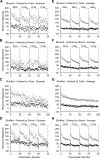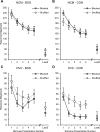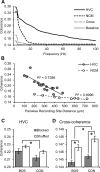Principles of auditory processing differ between sensory and premotor structures of the songbird forebrain
- PMID: 28031398
- PMCID: PMC5349330
- DOI: 10.1152/jn.00462.2016
Principles of auditory processing differ between sensory and premotor structures of the songbird forebrain
Abstract
Sensory and motor brain structures work in collaboration during perception. To evaluate their respective contributions, the present study recorded neural responses to auditory stimulation at multiple sites simultaneously in both the higher-order auditory area NCM and the premotor area HVC of the songbird brain in awake zebra finches (Taeniopygia guttata). Bird's own song (BOS) and various conspecific songs (CON) were presented in both blocked and shuffled sequences. Neural responses showed plasticity in the form of stimulus-specific adaptation, with markedly different dynamics between the two structures. In NCM, the response decrease with repetition of each stimulus was gradual and long-lasting and did not differ between the stimuli or the stimulus presentation sequences. In contrast, HVC responses to CON stimuli decreased much more rapidly in the blocked than in the shuffled sequence. Furthermore, this decrease was more transient in HVC than in NCM, as shown by differential dynamics in the shuffled sequence. Responses to BOS in HVC decreased more gradually than to CON stimuli. The quality of neural representations, computed as the mutual information between stimuli and neural activity, was higher in NCM than in HVC. Conversely, internal functional correlations, estimated as the coherence between recording sites, were greater in HVC than in NCM. The cross-coherence between the two structures was weak and limited to low frequencies. These findings suggest that auditory communication signals are processed according to very different but complementary principles in NCM and HVC, a contrast that may inform study of the auditory and motor pathways for human speech processing.NEW & NOTEWORTHY Neural responses to auditory stimulation in sensory area NCM and premotor area HVC of the songbird forebrain show plasticity in the form of stimulus-specific adaptation with markedly different dynamics. These two structures also differ in stimulus representations and internal functional correlations. Accordingly, NCM seems to process the individually specific complex vocalizations of others based on prior familiarity, while HVC responses appear to be modulated by transitions and/or timing in the ongoing sequence of sounds.
Keywords: electrophysiology, songbird; mutual information; sensory-motor structures; stimulus-specific adaptation.
Copyright © 2017 the American Physiological Society.
Figures









Similar articles
-
Changing neuroestrogens within the auditory forebrain rapidly transform stimulus selectivity in a downstream sensorimotor nucleus.J Neurosci. 2012 Jun 13;32(24):8231-41. doi: 10.1523/JNEUROSCI.1114-12.2012. J Neurosci. 2012. PMID: 22699904 Free PMC article.
-
Familiar But Unexpected: Effects of Sound Context Statistics on Auditory Responses in the Songbird Forebrain.J Neurosci. 2017 Dec 6;37(49):12006-12017. doi: 10.1523/JNEUROSCI.5722-12.2017. Epub 2017 Nov 8. J Neurosci. 2017. PMID: 29118103 Free PMC article.
-
Linear and nonlinear auditory response properties of interneurons in a high-order avian vocal motor nucleus during wakefulness.J Neurophysiol. 2012 Apr;107(8):2185-201. doi: 10.1152/jn.01003.2009. Epub 2011 Dec 28. J Neurophysiol. 2012. PMID: 22205651 Free PMC article.
-
Functional organization of forebrain pathways for song production and perception.J Neurobiol. 1997 Nov;33(5):671-93. doi: 10.1002/(sici)1097-4695(19971105)33:5<671::aid-neu12>3.0.co;2-c. J Neurobiol. 1997. PMID: 9369466 Review.
-
A species-specific view of song representation in a sensorimotor nucleus.J Physiol Paris. 2013 Jun;107(3):193-202. doi: 10.1016/j.jphysparis.2012.08.004. Epub 2012 Aug 30. J Physiol Paris. 2013. PMID: 22960663 Review.
Cited by
-
Rapid and long-lasting improvements in neural discrimination of acoustic signals with passive familiarization.PLoS One. 2019 Aug 29;14(8):e0221819. doi: 10.1371/journal.pone.0221819. eCollection 2019. PLoS One. 2019. PMID: 31465431 Free PMC article.
-
HDAC3 Inhibitor RGFP966 Modulates Neuronal Memory for Vocal Communication Signals in a Songbird Model.Front Syst Neurosci. 2017 Sep 5;11:65. doi: 10.3389/fnsys.2017.00065. eCollection 2017. Front Syst Neurosci. 2017. PMID: 28928640 Free PMC article.
-
Effects of Cortical FoxP1 Knockdowns on Learned Song Preference in Female Zebra Finches.eNeuro. 2023 Mar 29;10(3):ENEURO.0328-22.2023. doi: 10.1523/ENEURO.0328-22.2023. Print 2023 Mar. eNeuro. 2023. PMID: 36931727 Free PMC article.
-
Neuroestrogens rapidly shape auditory circuits to support communication learning and perception: Evidence from songbirds.Horm Behav. 2018 Aug;104:77-87. doi: 10.1016/j.yhbeh.2018.03.007. Epub 2018 Mar 30. Horm Behav. 2018. PMID: 29555375 Free PMC article. Review.
-
Neuroestrogen synthesis modifies neural representations of learned song without altering vocal imitation in developing songbirds.Sci Rep. 2020 Feb 27;10(1):3602. doi: 10.1038/s41598-020-60329-3. Sci Rep. 2020. PMID: 32108169 Free PMC article.
References
Publication types
MeSH terms
LinkOut - more resources
Full Text Sources
Other Literature Sources

